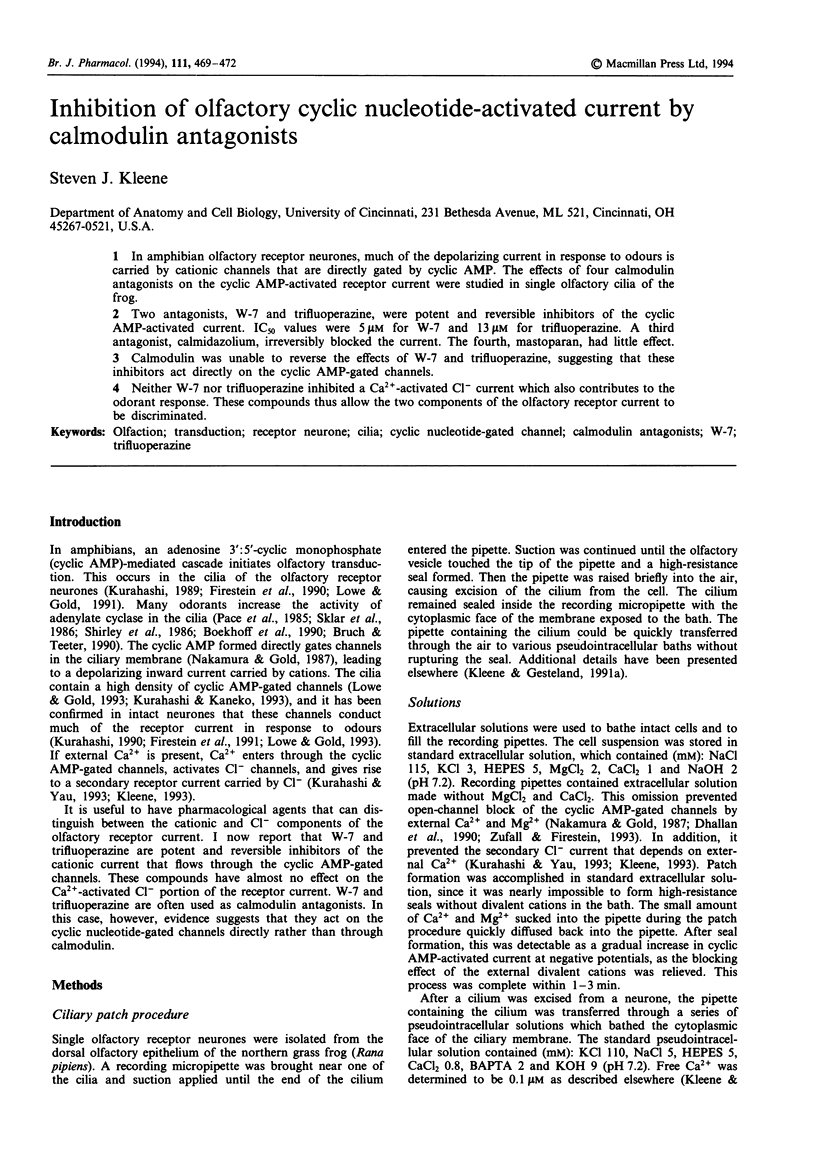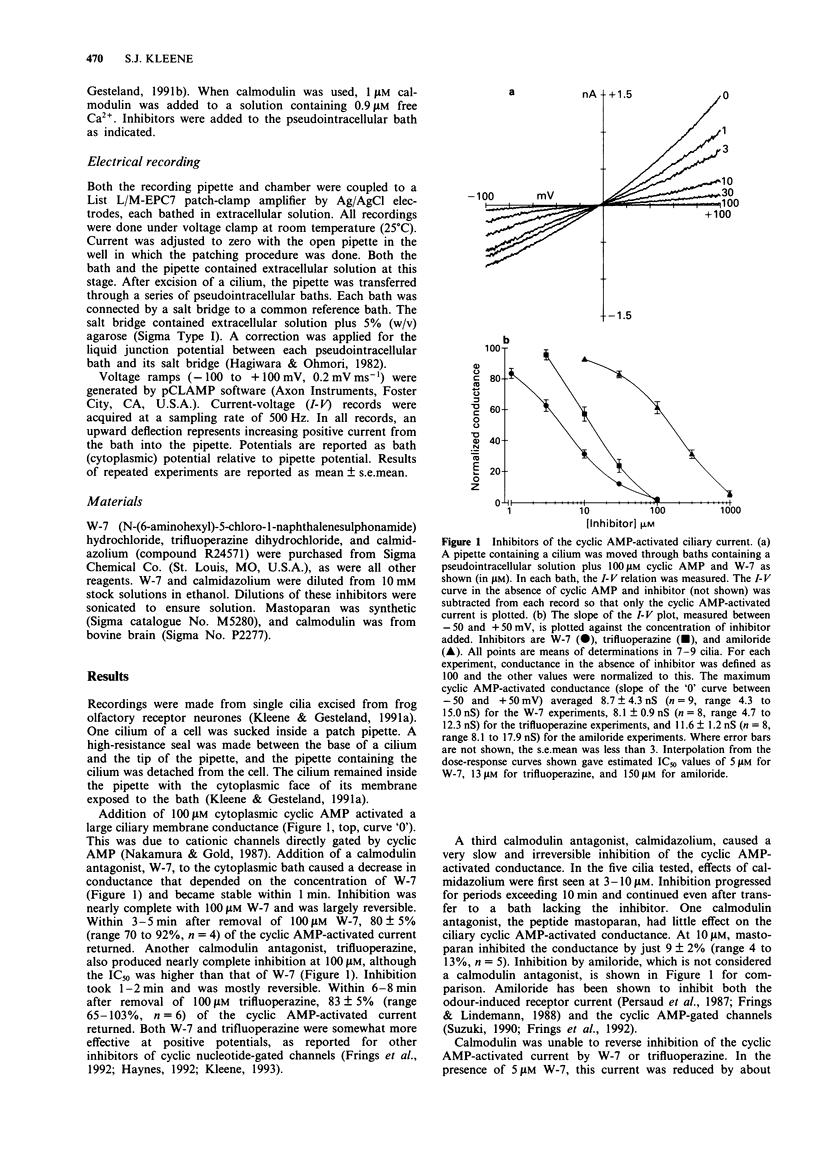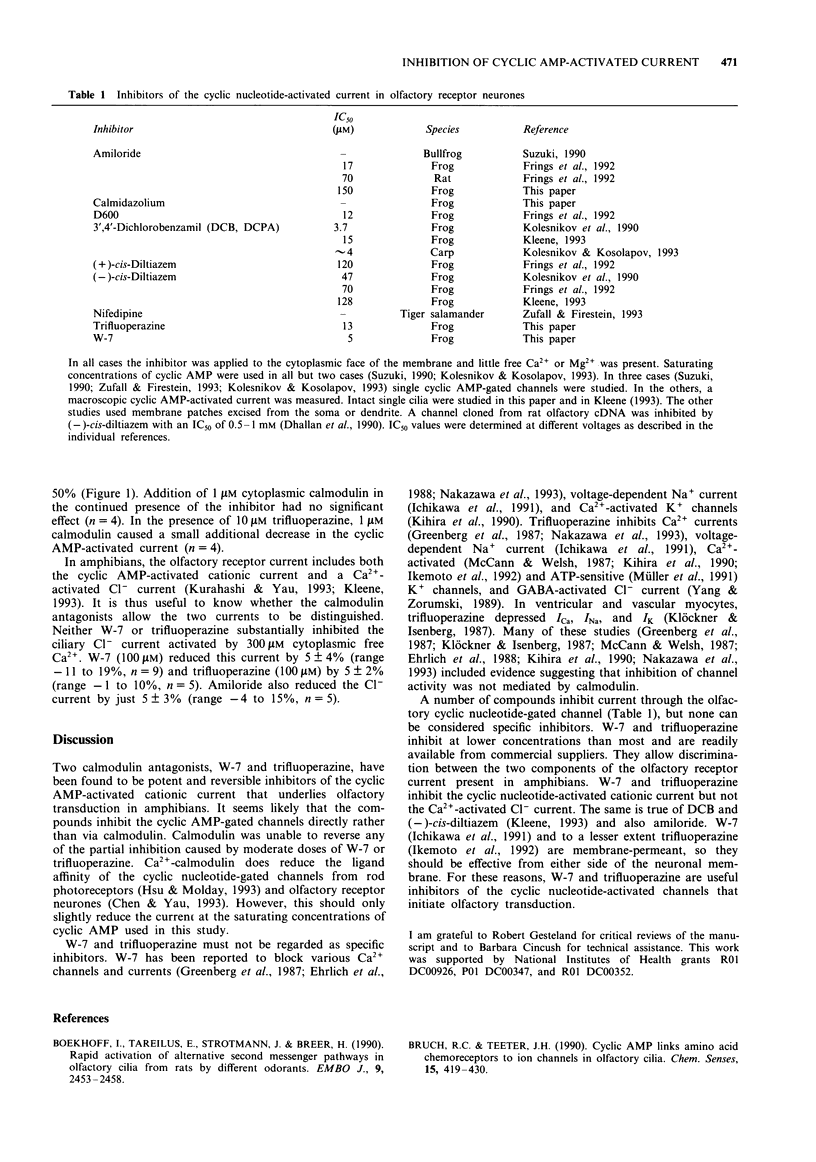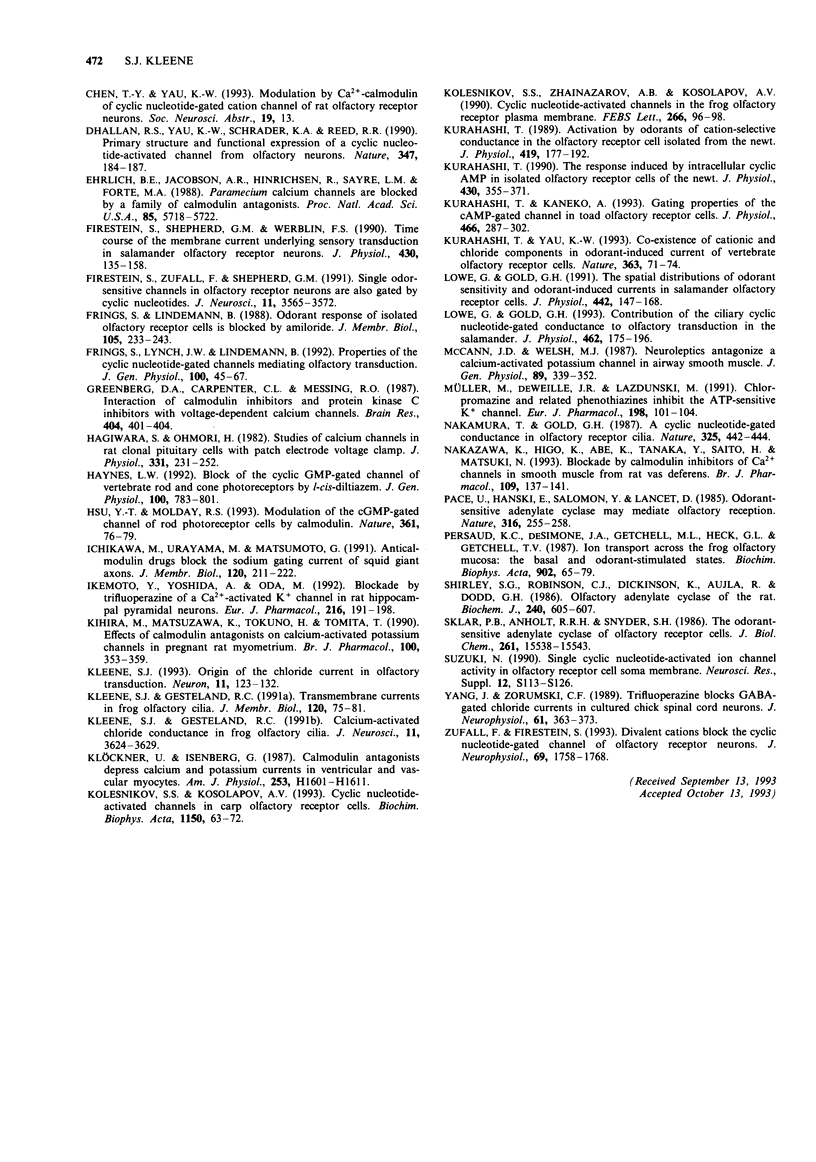Abstract
1. In amphibian olfactory receptor neurones, much of the depolarizing current in response to odours is carried by cationic channels that are directly gated by cyclic AMP. The effects of four calmodulin antagonists on the cyclic AMP-activated receptor current were studied in single olfactory cilia of the frog. 2. Two antagonists, W-7 and trifluoperazine, were potent and reversible inhibitors of the cyclic AMP-activated current. IC50 values were 5 microM for W-7 and 13 microM for trifluoperazine. A third antagonist, calmidazolium, irreversibly blocked the current. The fourth, mastoparan, had little effect. 3. Calmodulin was unable to reverse the effects of W-7 and trifluoperazine, suggesting that these inhibitors act directly on the cyclic AMP-gated channels. 4. Neither W-7 nor trifluoperazine inhibited a Ca(2+)-activated Cl- current which also contributes to the odorant response. These compounds thus allow the two components of the olfactory receptor current to be discriminated.
Full text
PDF



Selected References
These references are in PubMed. This may not be the complete list of references from this article.
- Boekhoff I., Tareilus E., Strotmann J., Breer H. Rapid activation of alternative second messenger pathways in olfactory cilia from rats by different odorants. EMBO J. 1990 Aug;9(8):2453–2458. doi: 10.1002/j.1460-2075.1990.tb07422.x. [DOI] [PMC free article] [PubMed] [Google Scholar]
- Dhallan R. S., Yau K. W., Schrader K. A., Reed R. R. Primary structure and functional expression of a cyclic nucleotide-activated channel from olfactory neurons. Nature. 1990 Sep 13;347(6289):184–187. doi: 10.1038/347184a0. [DOI] [PubMed] [Google Scholar]
- Ehrlich B. E., Jacobson A. R., Hinrichsen R., Sayre L. M., Forte M. A. Paramecium calcium channels are blocked by a family of calmodulin antagonists. Proc Natl Acad Sci U S A. 1988 Aug;85(15):5718–5722. doi: 10.1073/pnas.85.15.5718. [DOI] [PMC free article] [PubMed] [Google Scholar]
- Firestein S., Shepherd G. M., Werblin F. S. Time course of the membrane current underlying sensory transduction in salamander olfactory receptor neurones. J Physiol. 1990 Nov;430:135–158. doi: 10.1113/jphysiol.1990.sp018286. [DOI] [PMC free article] [PubMed] [Google Scholar]
- Firestein S., Zufall F., Shepherd G. M. Single odor-sensitive channels in olfactory receptor neurons are also gated by cyclic nucleotides. J Neurosci. 1991 Nov;11(11):3565–3572. doi: 10.1523/JNEUROSCI.11-11-03565.1991. [DOI] [PMC free article] [PubMed] [Google Scholar]
- Frings S., Lindemann B. Odorant response of isolated olfactory receptor cells is blocked by amiloride. J Membr Biol. 1988 Nov;105(3):233–243. doi: 10.1007/BF01871000. [DOI] [PubMed] [Google Scholar]
- Frings S., Lynch J. W., Lindemann B. Properties of cyclic nucleotide-gated channels mediating olfactory transduction. Activation, selectivity, and blockage. J Gen Physiol. 1992 Jul;100(1):45–67. doi: 10.1085/jgp.100.1.45. [DOI] [PMC free article] [PubMed] [Google Scholar]
- Greenberg D. A., Carpenter C. L., Messing R. O. Interaction of calmodulin inhibitors and protein kinase C inhibitors with voltage-dependent calcium channels. Brain Res. 1987 Feb 24;404(1-2):401–404. doi: 10.1016/0006-8993(87)91403-x. [DOI] [PubMed] [Google Scholar]
- Hagiwara S., Ohmori H. Studies of calcium channels in rat clonal pituitary cells with patch electrode voltage clamp. J Physiol. 1982 Oct;331:231–252. doi: 10.1113/jphysiol.1982.sp014371. [DOI] [PMC free article] [PubMed] [Google Scholar]
- Haynes L. W. Block of the cyclic GMP-gated channel of vertebrate rod and cone photoreceptors by l-cis-diltiazem. J Gen Physiol. 1992 Nov;100(5):783–801. doi: 10.1085/jgp.100.5.783. [DOI] [PMC free article] [PubMed] [Google Scholar]
- Hsu Y. T., Molday R. S. Modulation of the cGMP-gated channel of rod photoreceptor cells by calmodulin. Nature. 1993 Jan 7;361(6407):76–79. doi: 10.1038/361076a0. [DOI] [PubMed] [Google Scholar]
- Ichikawa M., Urayama M., Matsumoto G. Anticalmodulin drugs block the sodium gating current of squid giant axons. J Membr Biol. 1991 Mar;120(3):211–222. doi: 10.1007/BF01868532. [DOI] [PubMed] [Google Scholar]
- Ikemoto Y., Yoshida A., Oda M. Blockade by trifluoperazine of a Ca(2+)-activated K+ channel in rat hippocampal pyramidal neurons. Eur J Pharmacol. 1992 Jun 5;216(2):191–198. doi: 10.1016/0014-2999(92)90360-g. [DOI] [PubMed] [Google Scholar]
- Kihira M., Matsuzawa K., Tokuno H., Tomita T. Effects of calmodulin antagonists on calcium-activated potassium channels in pregnant rat myometrium. Br J Pharmacol. 1990 Jun;100(2):353–359. doi: 10.1111/j.1476-5381.1990.tb15808.x. [DOI] [PMC free article] [PubMed] [Google Scholar]
- Kleene S. J., Gesteland R. C. Calcium-activated chloride conductance in frog olfactory cilia. J Neurosci. 1991 Nov;11(11):3624–3629. doi: 10.1523/JNEUROSCI.11-11-03624.1991. [DOI] [PMC free article] [PubMed] [Google Scholar]
- Kleene S. J., Gesteland R. C. Transmembrane currents in frog olfactory cilia. J Membr Biol. 1991 Feb;120(1):75–81. doi: 10.1007/BF01868593. [DOI] [PubMed] [Google Scholar]
- Kleene S. J. Origin of the chloride current in olfactory transduction. Neuron. 1993 Jul;11(1):123–132. doi: 10.1016/0896-6273(93)90276-w. [DOI] [PubMed] [Google Scholar]
- Kolesnikov S. S., Kosolapov A. V. Cyclic nucleotide-activated channels in carp olfactory receptor cells. Biochim Biophys Acta. 1993 Jul 25;1150(1):63–72. doi: 10.1016/0005-2736(93)90122-g. [DOI] [PubMed] [Google Scholar]
- Kolesnikov S. S., Zhainazarov A. B., Kosolapov A. V. Cyclic nucleotide-activated channels in the frog olfactory receptor plasma membrane. FEBS Lett. 1990 Jun 18;266(1-2):96–98. doi: 10.1016/0014-5793(90)81515-p. [DOI] [PubMed] [Google Scholar]
- Kurahashi T. Activation by odorants of cation-selective conductance in the olfactory receptor cell isolated from the newt. J Physiol. 1989 Dec;419:177–192. doi: 10.1113/jphysiol.1989.sp017868. [DOI] [PMC free article] [PubMed] [Google Scholar]
- Kurahashi T., Kaneko A. Gating properties of the cAMP-gated channel in toad olfactory receptor cells. J Physiol. 1993 Jul;466:287–302. [PMC free article] [PubMed] [Google Scholar]
- Kurahashi T. The response induced by intracellular cyclic AMP in isolated olfactory receptor cells of the newt. J Physiol. 1990 Nov;430:355–371. doi: 10.1113/jphysiol.1990.sp018295. [DOI] [PMC free article] [PubMed] [Google Scholar]
- Kurahashi T., Yau K. W. Co-existence of cationic and chloride components in odorant-induced current of vertebrate olfactory receptor cells. Nature. 1993 May 6;363(6424):71–74. doi: 10.1038/363071a0. [DOI] [PubMed] [Google Scholar]
- Lowe G., Gold G. H. Contribution of the ciliary cyclic nucleotide-gated conductance to olfactory transduction in the salamander. J Physiol. 1993 Mar;462:175–196. doi: 10.1113/jphysiol.1993.sp019550. [DOI] [PMC free article] [PubMed] [Google Scholar]
- Lowe G., Gold G. H. The spatial distributions of odorant sensitivity and odorant-induced currents in salamander olfactory receptor cells. J Physiol. 1991 Oct;442:147–168. doi: 10.1113/jphysiol.1991.sp018787. [DOI] [PMC free article] [PubMed] [Google Scholar]
- McCann J. D., Welsh M. J. Neuroleptics antagonize a calcium-activated potassium channel in airway smooth muscle. J Gen Physiol. 1987 Feb;89(2):339–352. doi: 10.1085/jgp.89.2.339. [DOI] [PMC free article] [PubMed] [Google Scholar]
- Müller M., De Weille J. R., Lazdunski M. Chlorpromazine and related phenothiazines inhibit the ATP-sensitive K+ channel. Eur J Pharmacol. 1991 May 30;198(1):101–104. doi: 10.1016/0014-2999(91)90569-c. [DOI] [PubMed] [Google Scholar]
- Nakamura T., Gold G. H. A cyclic nucleotide-gated conductance in olfactory receptor cilia. 1987 Jan 29-Feb 4Nature. 325(6103):442–444. doi: 10.1038/325442a0. [DOI] [PubMed] [Google Scholar]
- Nakazawa K., Higo K., Abe K., Tanaka Y., Saito H., Matsuki N. Blockade by calmodulin inhibitors of Ca2+ channels in smooth muscle from rat vas deferens. Br J Pharmacol. 1993 May;109(1):137–141. doi: 10.1111/j.1476-5381.1993.tb13543.x. [DOI] [PMC free article] [PubMed] [Google Scholar]
- Pace U., Hanski E., Salomon Y., Lancet D. Odorant-sensitive adenylate cyclase may mediate olfactory reception. Nature. 1985 Jul 18;316(6025):255–258. doi: 10.1038/316255a0. [DOI] [PubMed] [Google Scholar]
- Persaud K. C., DeSimone J. A., Getchell M. L., Heck G. L., Getchell T. V. Ion transport across the frog olfactory mucosa: the basal and odorant-stimulated states. Biochim Biophys Acta. 1987 Aug 7;902(1):65–79. doi: 10.1016/0005-2736(87)90136-2. [DOI] [PubMed] [Google Scholar]
- Shirley S. G., Robinson C. J., Dickinson K., Aujla R., Dodd G. H. Olfactory adenylate cyclase of the rat. Stimulation by odorants and inhibition by Ca2+. Biochem J. 1986 Dec 1;240(2):605–607. doi: 10.1042/bj2400605. [DOI] [PMC free article] [PubMed] [Google Scholar]
- Sklar P. B., Anholt R. R., Snyder S. H. The odorant-sensitive adenylate cyclase of olfactory receptor cells. Differential stimulation by distinct classes of odorants. J Biol Chem. 1986 Nov 25;261(33):15538–15543. [PubMed] [Google Scholar]
- Suzuki N. Single cyclic nucleotide-activated ion channel activity in olfactory receptor cell soma membrane. Neurosci Res Suppl. 1990;12:S113–S126. doi: 10.1016/0921-8696(90)90013-s. [DOI] [PubMed] [Google Scholar]
- Yang J., Zorumski C. F. Trifluoperazine blocks GABA-gated chloride currents in cultured chick spinal cord neurons. J Neurophysiol. 1989 Feb;61(2):363–373. doi: 10.1152/jn.1989.61.2.363. [DOI] [PubMed] [Google Scholar]
- Zufall F., Firestein S. Divalent cations block the cyclic nucleotide-gated channel of olfactory receptor neurons. J Neurophysiol. 1993 May;69(5):1758–1768. doi: 10.1152/jn.1993.69.5.1758. [DOI] [PubMed] [Google Scholar]


